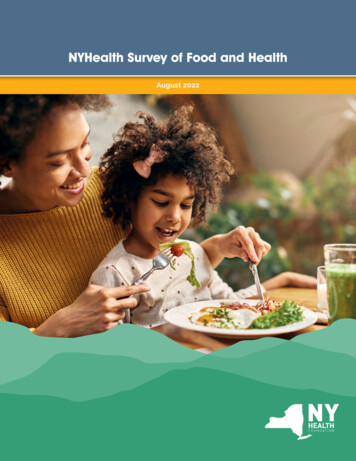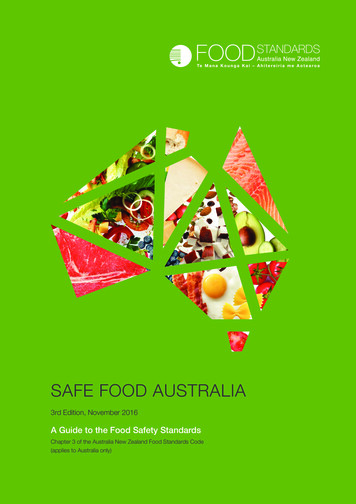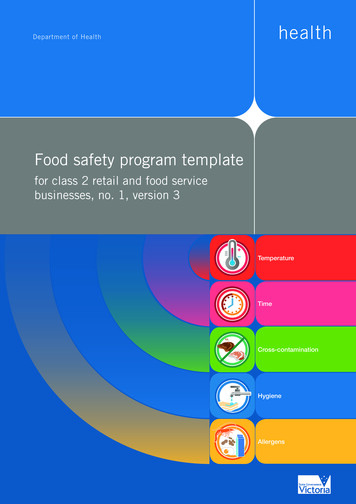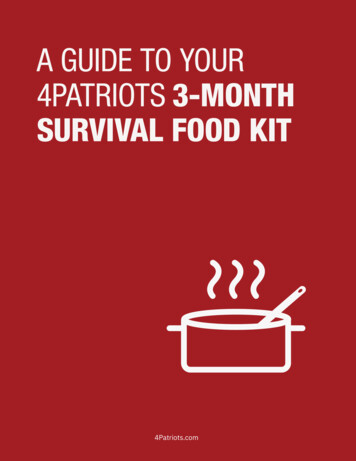
Transcription
NYHealth Survey of Food and HealthAugust 2022
Contents1 Executive Summary5 Introduction7 Methods8 R esults8 Connections Between Food And Health10 B arriers To Healthy Eating18 Tradeoffs and Coping Strategies20 Public Benefit Programs25 Policy Solutions27 Conclusions and Recommendations
Executive SummaryAcross New York State, food insecurity—the lack of consistent access to enough food foran active, healthy life—is prevalent, persistent, and costly.1 Prior to the COVID-19 pandemic,one in ten New Yorkers—nearly two million people—were food insecure.2 Public benefitprograms provide a critical safety net for hungry New Yorkers. But with rising food andgas prices as well as overall inflation, getting and affording food has become even harder,meaning that rates of food insecurity are likely to be even higher now.Food insecurity jeopardizes health. Evidence proves that individuals with uncertain accessto food have lower diet quality, higher rates of diet-related disease, and higher health carecosts. 3,4,5,6 A 2019 study estimated that in New York State, the annual health care costsassociated with food insecurity top 3.4 billion, or approximately 173 per person.7Until now, surveys of food-insecure New Yorkers have focused on estimating the numberof residents who have inconsistent or precarious access to food. This survey dives deepinto the lived experiences of New Yorkers who are food insecure and contrasts them withthe food-secure population. The ensuing report details the results of a 1,507-person statewide survey. It describes the connections between food and New Yorkers’ health, the multiple reasons why obtaining and preparing food can be difficult, and the perilous tradeoffs that1 U.S. Department of Agriculture, Economic Research Center. Definition of food security. April of-food-security/.Accessed April 2022.2 Coleman-Jensen A, Rabbitt MR, Hashad RN, Hales L, Gregroy CA. Prevalence of household-level food insecurityand very low food security, average 2018-20. U.S. Department of Agriculture, Economic Research Center. April 22,2022. aphics/#map.Accessed April 2022.3 Morales ME, Berkowitz SA. The relationship between food insecurity, dietary patterns, and obesity. Curr Nutr Rep.2016 Mar;5(1):54-60.4 Berkowitz SA, Basu S, Meigs JB, Seligman HK. Food insecurity and health care expenditures in the United States,2011-2013. Health Serv Res. 2018;53(3):1600-1620.5 Gregory CA, Coleman-Jensen A. Food insecurity, chronic disease, and health among working-age adults.U.S. Department of Agriculture, Economic Research Service. July 2017. No. 84467/err-235.pdf. Accessed April 2022.6 Berkowitz SA, Seligman HK, Meigs JB, Basu S. Food insecurity, health care utilization, and high cost: a longitudinalcohort study. Am J Manag Care. 2018;24(9):399–404.7 Berkowitz SA, Basu S, Gundersen C, Seligman HK. State-level and county-level estimates of health care costsassociated with food insecurity. Prev Chronic Dis. 2019;16:180549.NYHealth Survey of Food and Health1
Executive Summary(continued)individuals make to put meals on the table. It captures New Yorkers’ experiences with safetynet programs and their opinions about public policy actions; it also recommends steps toimprove food security and health going forward.Key FindingsConnections Between Food and Health Food-insecure individuals are twice as likely as food-secure individuals to rate their healthas “fair” or “poor.” Only 14% of food-insecure individuals report “excellent” health. Sixty-nine percent of food-insecure individuals report having at least one chronic physicalor mental illness. Twenty-one percent of food-insecure individuals delay or skip medical care, and 13% delayor do not purchase prescription medication.Barriers to Healthy Eating Approximately two-thirds of food-insecure individuals report that it is “extremely” or“somewhat” difficult to afford food. For a majority of food-insecure individuals, transportation is, at least sometimes, a barrierto getting the food they need. Fifty-eight percent of food-insecure individuals have trouble cooking at home. Time isthe most consistently reported barrier, but basics like space for storage and lack of accessto appliances are also problems.Tradeoffs and Coping Strategies When shopping for groceries, 65% of food-insecure New Yorkers buy cheaper foodsor foods on sale. Approximately half of food-insecure individuals eat less to stretch the food that theycan afford. Other common coping mechanisms include buying generic brands and shelf-stable foodsthat don’t go bad quickly.NYHealth Survey of Food and Health2
Executive Summary(continued)Public Benefit Programs Among food-insecure New Yorkers, one quarter (28%) did not participate in any emergency or food benefits program such as the Supplemental Nutrition Assistance Program(SNAP) or the Special Supplemental Nutrition Program for Women, Infants, and Children(WIC) in the last 12 months.Individuals who do participate in food benefits programs rate these programs highly. Eighty-nine percent of SNAP participants and 87% of WIC participants agree thatthe benefits are easy to use. Eighty-seven percent of families that participated in school meals in the last 12 monthsagree that the meals are helpful.Policy Solutions New Yorkers overwhelmingly agree that the State should make lunch free for all students:93% of food-insecure respondents and 83% of food-secure respondents support universalfree school meals. Ninety-six percent of families who used the Pandemic Electronic Benefit Transfer (P-EBT)program, a cash benefits program that acted as an alternative to traditional school meals,say the program should be available every summer. Ninety-three percent of the individuals who participated in WIC during this period wantthe services made available during the pandemic, such as remote benefit issuanceand re-enrollment, to be made permanent. New Yorkers agree that people should be able to apply for SNAP, WIC, and Medicaidthrough a single, streamlined application, and that it should be easier for families to useSNAP benefits to purchase groceries online. A majority of New Yorkers backs a statewide tax on sugar-sweetened beverage distributors that would support children’s health efforts.NYHealth Survey of Food and Health3
Executive Summary(continued)Conclusions and RecommendationsWhile many studies focus on counting the population that is food insecure, this is the firstmajor research effort to document the lived experiences of such New Yorkers. The resultsare clear: food insecurity is strongly associated with worse health.Policymakers and health care providers in New York can take action to reduce food insecurity and its associated harms. As a first step, policymakers can work to maximize participation in SNAP and WIC. Targeting outreach, easing application and recertification burdens oneligible participants, and covering the costs of online grocery delivery could not only lowerfood insecurity rates but also decrease health care expenditures for the State. For familieswith children, policymakers can work to permanently extend universal school meals statewideand provide cash benefits like P-EBT over the summer.To support food security programs, and in turn improve health, health care providers canimplement food insecurity screening and referral processes. They can also support Food IsMedicine interventions, such as medically tailored meals. Advocating for Food Is Medicineprograms to be eligible for Medicaid reimbursement could ultimately help connect peopleto the healthy food they need to thrive.NYHealth Survey of Food and Health4
IntroductionAcross New York State, food insecurity—the lack of consistent access to enough food foran active, healthy life—is prevalent, persistent, and costly. 8 Prior to the pandemic, one inten New Yorkers—nearly two million people—were food insecure.9 Low-income individuals,Hispanic and Black individuals, females, and individuals living in Bronx and Kings Countieswere among those most likely to be food insecure.10Public benefit programs like the Supplemental Nutrition Assistance Program (SNAP); the SpecialSupplemental Nutrition Program for Women, Infants, and Children (WIC); and the NationalSchool Lunch and Breakfast Programs provide a critical safety net for hungry New Yorkers.But high costs of living in the State mean many continue to go without the food they need.Rates of food insecurity are not likely to reverse any time soon. Food prices are currentlythe highest in decades and predicted to increase.11 Since this survey was administered, food,gas prices, and inflation have risen drastically, making the situation likely even more direthan presented in this report.Food insecurity jeopardizes New Yorkers’ health. Individuals with uncertain access to foodare more likely to have lower diet quality, higher rates of diet-related disease, and higher8 U.S. Department of Agriculture, Economic Research Center. Definition of food security. April of-food-security/.Accessed April 2022.9 Coleman-Jensen A, Rabbitt MR, Hashad RN, Hales L, Gregroy CA. Prevalence of household-level food insecurity andvery low food security, average 2018-20. U.S. Department of Agriculture, Economic Research Center. April 22, cs-graphics/#map.Accessed April 2022.10 New York State Department of Health. Perceived food insecurity: New York State adults, 2016.U.S. Centers for Disease Control and Prevention Behavioral Risk Factor Surveillance System. No. ports/docs/1810 food security.pdf. Accessed May 2022.11 U.S. Department of Agriculture, Economic Research Center. Food price outlook, 2022. April 25, rice-outlook/summary-findings/#: :text and%20March%202022. Accessed April 2022.NYHealth Survey of Food and Health5
Introduction(continued)health care costs.12,13,14,15 A 2019 study estimated that in New York, the annual health carecosts associated with food insecurity top 3.4 billion, or approximately 173 per person.16These costs are likely even higher in 2022, given the ongoing COVID-19 pandemic andincreasing food prices. Health care costs associated with food insecurity increase when foodinsecurity increases, possibly because tradeoffs between food and basics like medicinemake managing chronic diseases more challenging.17Understanding the lived experiences of food-insecure New Yorkers is key to developingpolicy solutions. When crafting policy, there is no substitute for listening to the voicesof those directly affected. Based on the results of a 1,507-person statewide survey, thisreport details the connections between food and health, the reasons why obtaining and preparing food are difficult for food-insecure individuals, and the perilous tradeoffs that theseindividuals make to put meals on the table. It illustrates how food experiences differ forNew Yorkers with chronic illnesses and those of different races and ethnicities. This reportalso presents New Yorkers’ perspectives on food benefit programs and potential policies toalleviate food insecurity. Finally, it recommends actions to improve food security and health.Complete data tables with survey responses referenced in this report are available inan online Appendix.12 Morales ME, Berkowitz SA. The relationship between food insecurity, dietary patterns, and obesity.Curr Nutr Rep. 2016 Mar;5(1):54-60.13 Berkowitz SA, Basu S, Meigs JB, Seligman HK. Food insecurity and health care expenditures in the United States,2011-2013. Health Serv Res. 2018;53(3):1600-1620.14 Gregory CA, Coleman-Jensen A. Food insecurity, chronic disease, and health among working-age adults.U.S. Department of Agriculture, Economic Research Service. July 2017. No. 84467/err-235.pdf. Accessed April 2022.15 Berkowitz SA, Seligman HK, Meigs JB, Basu S. Food insecurity, health care utilization, and high cost: a longitudinalcohort study. Am J Manag Care. 2018;24(9):399–404.16 Berkowitz SA, Basu S, Gundersen C, Seligman HK. State-level and county-level estimates of health care costsassociated with food insecurity. Prev Chronic Dis. 2019;16:180549.17 Berkowitz SA, Seligman HK, Choudhry NK. Treat or eat: food insecurity, cost-related medication underuse, and unmetneeds. Am J Med. 2014 Apr;127(4):303-310.e3.NYHealth Survey of Food and Health6
MethodsTo learn from individuals living with food insecurity, the New York Health Foundation (NYHealth)developed and commissioned a large statewide survey. Professional research firm Luminasinitially conducted an online focus group with food-insecure individuals to determine potentialparticipants’ understanding of both the survey questions and response options. During thefocus group, Luminas reviewed select survey questions and asked a series of related followup questions. Participants were reimbursed for their time.Following the focus group, survey respondents were recruited from online panels. All respondents completed USDA’s Six-Item Short Form Food Security Survey Module, identified their stateof residence (New York), and provided their age (18 or greater) to determine eligibility for thelarger survey.18 The USDA food insecurity and security definitions were used to determine whichrespondents were food secure versus food insecure. Respondents who answered “yes” or “oftenor sometimes true” to two or more of the six-item screener were considered food insecure.19A total of 1,507 New York adults completed the online survey (500 food secure; 1,007 foodinsecure), available in both English and Spanish. The survey was conducted November 24through December 6, 2021 and took approximately 12 minutes to complete.Survey data were weighted by gender, race, ethnicity, education, and household income toreflect New York State’s population. The benchmark weight targets were drawn from the 2019U.S. Census for New York State. Approximate margins of error for this study appear in Table 1.T A B L E 1: Margins of Error for NYHealth Survey of Food and HealthSample Sizen 500 (food secure)Sampling Error /- 4%n 1000 (food insecure) /- 3%n 1,500 (food secure insecure) /- 3%Source: Margins of error estimated by Luminas, LLC.18 U.S. Department of Agriculture, Economic Research Service. U.S. household food security survey module: six-itemshort form. September 2012. https://www.ers.usda.gov/media/8282/short2012.pdf. Accessed April 2022. Note that twoquestions were combined into one as discussed in the documentation, so only five food security screener questionswere used in this survey.19 USDA defines food insecurity as a household-level economic and social condition of limited or uncertain accessto adequate food. Food security occurs when individuals have consistent, dependable access to enough food foractive, healthy living.NYHealth Survey of Food and Health7
ResultsConnections Between Food and HealthFood-Insecure New Yorkers Are Twice as Likely to Report Unsatisfactory HealthIn New York State, nearly half of all food-insecure individuals (48%), compared with 23% offood-secure individuals, rate their health as “fair” or “poor.” Among food-insecure New Yorkers,people of different races and ethnicities perceive their health differently: 56% of Asian, 51%of Hispanic, 49% of Black, and 45% of white respondents report their health as “fair” or “poor.”Nearly half of all food-insecure individuals (48%), compared with 23%of food-secure individuals, rate their health as “fair” or “poor.”Only 14% of food-insecure individuals report “excellent” health. Self-reported health isproven to be reliable. People who rate their health as “poor” have a mortality risk rate thatis twice the rate of people who rate their health as “excellent.”20F I G U R E 1: Food Security and Health StatusSELF-REPORTED HEALTH 6080PoorFairGood100ExcellentSELF-REPORTED HEALTH BY RACE (FOOD 418White44017374060Poor80FairGood100Excellent20 DeSalvo KB, Bloser N, Reynolds K, He J, Muntner P. Mortality prediction with a single general self-rated health question.A meta-analysis. J Gen Intern Med. 2006 Mar;21(3):267-75.NYHealth Survey of Food and Health8
Results(continued)Food-Insecure New Yorkers Experience Chronic Illness at High RatesSixty-nine percent of food-insecure individuals report having at least one mental or physicalchronic illness. 21 This rate is notably higher than the rate for food-secure New Yorkers(59%). For both populations, stress, anxiety, and depression are the most common healthconditions. Among food-insecure New Yorkers, other commonly reported health conditionsinclude high blood pressure, high cholesterol, overweight/obesity, and diabetes.F I G U R E 2 : Food Security and Chronic Illness8070Food-Secure New YorkersFood-Insecure New Yorkers605040302010059%69%Any 25%High /obesity9%14%DiabetesFood-Insecure New Yorkers Sacrifice their Health CareTo feed their families, food-insecure individuals may sacrifice their health care. Twentyone percent delay or skip medical care, and 13% delay or do not purchase prescriptionmedication. For chronically ill food-insecure individuals, these rates are even higher. Twentythree percent of such individuals—individuals more likely to need medical care and medicine—delay or skip medical care, and 16% delay or simply do not buy prescription medicine.Twenty-three percent of chronically ill food-insecure New Yorkersdelay or skip medical care, and 16% delay or simply do not buyprescription medicine.21 Respondents reported the following chronic illnesses: attention deficit hyperactivity disorder, cancer, diabetes, heartdisease, high blood pressure, high cholesterol, muscle strength/mobility issues, osteoporosis, overweight/obesity, stress/anxiety/depression, stroke, and other.NYHealth Survey of Food and Health9
Results(continued)F I G U R E 3 : H ealth Care Sacrifices Among Food-Insecure New Yorkers25201510521%13%Delay/skip medical careDelay/skip medicine0Barriers To Healthy EatingFood-Insecure New Yorkers Are Nearly Nine Times as Likely to Report DifficultyObtaining FoodMany New Yorkers live on the edge of hunger. More than half of food-insecure individuals (53%),compared with just 6% of food-secure individuals, report that it is “extremely” or “somewhat”difficult to get the food they need. According to one survey respondent, “We have had to gowithout food many nights.” Not surprisingly, lack of money is the most frequently cited difficulty.Transportation and lack of healthy, high-quality options are also common challenges.“We have had to go without food many nights.”F I G U R E 4 : N ew Yorkers Who Say it Is Extremely/Somewhat Difficult to Get Food60504030201006%Food-Secure New YorkersNYHealth Survey of Food and Health53%Food-Insecure New Yorkers10
Results(continued)Chronically Ill and Hispanic Individuals Are More Likely to Face BarriersGetting FoodAmong the food-insecure population, there are notable differences in the degree of difficulty obtaining food based on health status, as well as race and ethnicity.F I G U R E 5 : F ood-Insecure New Yorkers Who Say Getting Food Is Extremelyor Somewhat DifficultChronicallyIllHEALTH STATUSRACE51%Asian61%50%Black/AA60%NotChronically IllHispanic36%50%White02040600204060Cost Is a Major Barrier for Two of Every Three Food-Insecure New YorkersCost is the main barrier when it comes to New Yorkers getting the food they need. Twothirds (64%) of all food-insecure individuals report that it is “extremely” or “somewhat” difficult to afford. “Weeks in between paychecks had the refrigerator kind of empty at times,”revealed one survey respondent. “We have access to the food but not the finances topurchase it,” explained another.“Weeks in between paychecks had the refrigerator kind of emptyat times.”NYHealth Survey of Food and Health11
Results(continued)F I G U R E 6 : N ew Yorkers Who Say Affording Food is Extremely or Somewhat Difficult807060504030201064%10%0Food-Secure New YorkersFood-Insecure New YorkersFor chronically ill food-insecure individuals, affording food is especially difficult: 72% struggle to afford the food they need. One survey respondent explained, “We don’t have enoughmoney for food because I’ve been in and out of the hospital.” Differences affording foodalso vary by race and ethnicity.For chronically ill food-insecure individuals, affording food is especially difficult: 72% struggle to afford the food they need.F I G U R E 7: F ood-Insecure New Yorkers Who Say Affording Food Is Extremelyor Somewhat DifficultChronicallyIllHEALTH STATUSRACE64%Asian72%69%NotChronically IllBlack/AA71%Hispanic45%59%White02040NYHealth Survey of Food and Health608002040608012
Results(continued)For Food-Insecure Individuals, Transportation Is a Common Barrier to Getting GroceriesA majority of food-insecure individuals (62%) report that transportation is, at least sometimes,a barrier to getting the food they need. The same is true for only 19% of individuals who arefood secure.The degree to which transportation is a barrier to healthy eating varies by health status,as well as race and ethnicity. For example, two-thirds (64%) of chronically ill food-insecureindividuals have difficulty getting the food they need, at least some of the time. “We areboth disabled and live on food stamps. We don’t drive, so getting to a food pantry is almostimpossible,” one individual explained. Food-insecure individuals who are Asian or Hispanicare more likely to have trouble with transportation, and food-insecure individuals who areBlack or white less likely, though still a majority.“We are both disabled and live on food stamps. We don’t drive,so getting to a food pantry is almost impossible.”FI GU RE 8: N ew Yorkers Who Say Transportation Is Sometimes, Often, or Alwaysa Barrier to Getting GroceriesOVERALLFood Secure 19%62%Food InsecureNotChronically IllChronicallyIll0204060FOOD-INSECURENEW YORKERS BY HEALTH STATUS80FOOD-INSECURENEW YORKERS BY lth Survey of Food and Health58%White608002040608013
Results(continued)Travel time to obtain food can be lengthy. Approximately 4 of every 10 food-insecure individuals (38%) travel more than 20 minutes each way to shop for food. These rates differby race and ethnicity.F I G U R E 9 : F ood-Insecure New Yorkers Who Say They Travel 20 Minutesto Shop for FoodOverall(Food 01020304050Access to a reliable means of transportation is another obstacle. For food-insecure individuals,using their own vehicle, walking or biking, and getting a ride from a friend or family memberare the most common means of transportation, followed by public transportation. Reliance onpublic transportation can restrict the food and beverages individuals purchase, as one surveyrespondent revealed: “We do not live within a reasonable distance of any supermarkets(we do not have a car) so are often limited to purchasing whatever we can carry on the bus.”NYHealth Survey of Food and Health14
Results(continued)F I G U R E 10 : H ow New Yorkers Get to Food StoresOVERALL14%Public transit20%69%Own vehicle52%5%Borrow vehicle7%11%Get ride fromfriend/family22%8%Taxi or car service12%22%Delivery service15%29%Walk or bike31%01020Food-Secure New YorkersNYHealth Survey of Food and Health3040506070Food-Insecure New Yorkers15
Results(continued)F I G U R E 10 : H ow New Yorkers Get to Food Stores (continued)FOOD-INSECURE NEW YORKERS BY HEALTH STATUS15%Public transit22%62%Own vehicle48%8%Borrow vehicle7%18%Get ride fromfriend/family23%9%Taxi or car service14%18%Delivery service14%22%Walk or bike35%010Not Chronically IllNYHealth Survey of Food and Health203040506070Chronically Ill16
Results(continued)F I G U R E 10 : H ow New Yorkers Get to Food Stores (continued)FOOD-INSECURE NEW YORKERS BY RACE35%26%Public transit25%15%33%33%Own vehicle37%66%9%11%Borrow vehicle9%5%14%30%Get ride fromfriend/family26%18%6%18%Taxi or car service15%11%6%21%Delivery service12%17%47%40%Walk or bike36%25%010Asian20Black /A ANYHealth Survey of Food and Health30Hispanic40506070White17
Results(continued)Most Food-Insecure New Yorkers Face Barriers to Cooking at HomeEven after obtaining the food they need, food-insecure individuals face challenges thataffect their diet, and consequently their health. A majority (58%) of food-insecure individualshave trouble cooking at home, with considerable racial and ethnic variation. Lack of time aswell as lack of basics like cooking equipment make food preparation difficult.F I G U R E 11: F ood-Insecure New Yorkers Who Have Difficult y Cooking at ite0Tradeoffs and Coping StrategiesNew Yorkers Make Tough Tradeoffs to Afford FoodWhen purchasing and planning meals, individuals struggling to afford food make a varietyof tough tradeoffs. Diet quality can suffer. For example, individuals buy cheaper foods orfoods on sale, eat less to stretch the food that they can afford, and buy generic brands or shelfstable foods that don’t go bad quickly.F I G U R E 12 : T radeoffs Food-Insecure New Yorkers Make to Afford Food65%Buy cheaper foods49%Stretch food/eat less48%Buy generic47%Buy foods that last longer41%Use coupons39%Shop at discount stores37%Buy more filling foods29%Visit a food pantry/soup kitchen27%Borrow money21%Use credit cards0NYHealth Survey of Food and Health1020304050607018
Results(continued)Black and Hispanic individuals struggling to afford food tend to make tradeoffs in ratesand patterns similar to those described above, but Asian individuals’ behaviors differ slightly.As common cost-saving measures, Asian individuals struggling to afford food are morelikely to use coupons (61%) and shop at discount stores (50%), but less likely to stretch foodby eating less (30%) or to visit a food pantry (14%).These tradeoffs can take a toll on individuals’ health. One survey respondent said, “Healthierfoods are more expensive, so we resort to cheaper unhealthy foods.” Another said, “We donot have a lot of money to purchase as much fresh produce as we’d like, so we are often leftpurchasing cheap, ready-made, or microwave meals.”“We do not have a lot of money to purchase as much fresh produceas we’d like, so we are often left purchasing cheap, ready-made,or microwave meals.”F I G U R E 13 : T radeoffs Among Food-Insecure New Yorkers, by Race and Ethnicit y8070AsianBlack /A ood/eatlessBuygenericNYHealth Survey of Food and HealthBuyfoodsthat lingfoodsVisita foodpantry/soupkitchenBorrowmoneyUsecreditcards19
Results(continued)When asked what could help them overcome barriers to get the food they need, foodinsecure individuals unsurprisingly say they need more money. But other solutionsare also desired, including financial support for food delivery, help applying for benefits,and improved transportation access.F I G U R E 14 : S olutions to Help Food-Insecure New Yorkers OvercomeBarriers to FoodMore money to payfor food/bills73%More money to payfor food delivery34%Help applying tofood programs24%More/differentfood in stores21%Info about foodprograms19%Better access topublic transit17%Different hoursat mealprograms/stores12%01020304050607080Public Benefit ProgramsNew Yorkers Participating in Food and Nutrition Programs Rate Them HighlyFood and nutrition programs are available to help New Yorkers access the food they need,in many cases increasing their food budgets. Individuals who participate in such programsrate these programs highly. Eighty-nine percent of SNAP participants and 87% of WICparticipants agree that the benefits are easy to use. Eighty-two percent of WIC participantsalso agree that their local stores carry enough WIC-approved items.Despite their popularity and effectiveness, program benefits are not always sufficient.Nearly half of SNAP participants and 28% of WIC participants say the benefits are notNYHealth Survey of Food and Health20
Results(continued)enough to meet their household’s needs. According to one survey respondent, “We getfood stamps, and sometimes it doesn’t last with what we need for the four of us.”“We get food stamps, and sometimes it doesn’t last with what weneed for the four of us.”To improve the program, individuals suggest increasing the benefits. Other popular suggestions include improving application and distribution methods (e.g., shorter approval timeline,multiple disbursements per month), expanding the types of items individuals can buywith SNAP and WIC (e.g., hot foods, milk of a different fat content), and expanding participanteligibility requirements (e.g., increase the income limit).F I G U R E 15 : S NAP and WIC Participants Who Strongly Agree Benefits Are Easy to UseSNAP ParticipantsWIC Participants89%87%School meal programs also serve as a vital safety net. Eighty-seven percent of families thatparticipated in school meals in the last 12 months agree that the meals are helpful. Threequarters (77%) of participating parents say their children like the meals provided. And twothirds (67%) agree that an adequate variety of meals is offered, reflecting cultural differencesand religious dietary needs.The most significant differences in p
NYHealth Survey of Food and Health 5 Across New York State, food insecurity—the lack of consistent access to enough food for an active, healthy life—is prevalent, persistent, and costly.8 Prior to the pandemic, one in ten New Yorkers—nearly two million people—were food insecure.9 Low-income individuals, Hispanic and Black individuals, females, and individuals living in Bronx and Kings .










